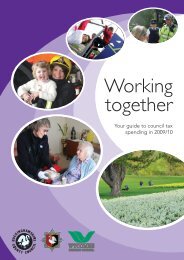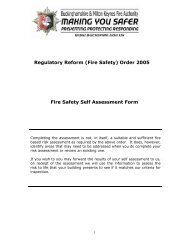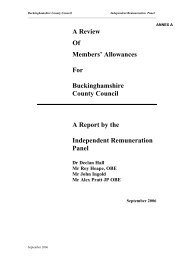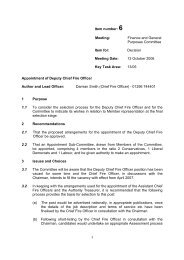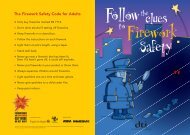Quarter One Integrated Risk Management Plan 2011-12 ...
Quarter One Integrated Risk Management Plan 2011-12 ...
Quarter One Integrated Risk Management Plan 2011-12 ...
You also want an ePaper? Increase the reach of your titles
YUMPU automatically turns print PDFs into web optimized ePapers that Google loves.
<strong>Quarter</strong> <strong>One</strong> <strong>Integrated</strong> <strong>Risk</strong> <strong>Management</strong> <strong>Plan</strong> (IRMP) <strong>2011</strong>-<strong>12</strong> Performance Monitoring Report<br />
2.1.4 Intelligence gathered in 2010-11 and during the first quarter continues to indicate home<br />
owners are experiencing the highest number of accidental dwelling fires (66 fires in this<br />
category during the 1 st quarter <strong>2011</strong>-<strong>12</strong>). Looking further at the occupancy types<br />
suggests that the highest proportion associated with owner occupied properties are<br />
couples with dependant child/ren and lone persons under pensionable age. Furthermore,<br />
26 accidental dwelling fires were reported within the same period in rented<br />
council/housing association with highest proportion; lone persons over pensionable age<br />
and 21 in privately rented accommodation with the highest proportion; lone persons<br />
under pensionable age.<br />
2.1.5 The number of fires that have been confined to the room of origin (Target 1.4) and so<br />
have not spread to other areas of the building have declined to 82 per cent during the<br />
first quarter compared to 85 per cent for the same period last year. This measure use to<br />
form a part of the best value suite of indicators and much controversy exists amongst<br />
the Fire and Rescue service nationally in determining the reliability of this measure as an<br />
indicator of our performance. For example; determining the extent of fire spread where<br />
the seat of the fire was near or directly within the vicinity of a doorway. A review of<br />
Service Delivery related targets is due to take place to inform the consideration of more<br />
relevant targets for the future. The change of three percentage points does not indicate<br />
a significant change in performance terms and this measure will be further monitored to<br />
identify if this is sustained before recommending any changes in current practice.<br />
2.1.6 The new Home Safety Check (HSC) administration and reporting procedure,<br />
implemented recently, will facilitate a more effective method of controlling this function.<br />
Stations now have local statistics and details of various social groups including their<br />
specific vulnerability to fire. This will aid targeting of HSCs to the most vulnerable<br />
persons. It is expected that the performance in monitoring the number of HSCs<br />
undertaken (Target 1.6) will improve dramatically in the next quarter and will have a<br />
positive impact on reducing the number of accidental dwelling fires (Target 1.1).<br />
2.2 Prevention 2: Working effectively with partners on education programmes<br />
which reduce risks to people from accidental and deliberate fires.<br />
2.2.1 Overall the number of primary fires in vehicles and secondary fires in buildings are<br />
declining (Targets 4.3b, 4.4a and 4.4b) aside from primary fires in buildings (excluding<br />
dwellings, Target 4.3a) which is marginally off the performance level set. These results<br />
on the surface, all reflect excellent performance of our service. However, these targets<br />
also reflect the “science of small numbers” compared to population group.<br />
Consequently, it follows that some caution is advised at this stage in seeking to attribute<br />
success or failure of our activity within these areas.<br />
2.3 Prevention 3: Working effectively with partners to reduce the number of road<br />
traffic collisions targeting young people and those most at risk.<br />
2.3.1 Once again this appears a very successful area and one to be celebrated (Target 3.1).<br />
The number reported killed and seriously injured during the first period of <strong>2011</strong>-<strong>12</strong> was<br />
61; that is a reduction of 14 compared to the same period last year. The systems that<br />
the service has in place for the education of young drivers, motor cycle riders and young<br />
pedestrians is well structured, well managed and offered in a very effective manner to all<br />
persons in these categories.<br />
2.4 Prevention 4: Reducing Anti-social behaviour and improving social well-being.<br />
2.4.1 Whilst the number of malicious false alarms have increased (Target 4.1) when compared<br />
to the same period last year, the number that we have attended has reduced (Target<br />
4.2). Our non attendance to malicious false alarms reflects an element of professional<br />
performance in respect of our control staff utilising call challenging methods to filter the<br />
extent of call validity.<br />
2.4.2 The number of malicious false alarms received (Target 4.1) has not achieved target.<br />
Going forward, more analysis and work will be required to address this trend.<br />
Executive Committee 6 th October <strong>2011</strong><br />
Page 4 of 6




